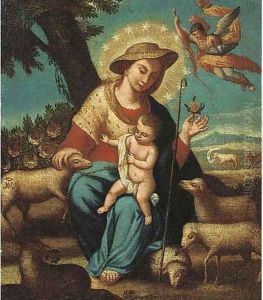Josefa De Ayala, Called Josefa D'Obidos Paintings
Josefa de Óbidos, born in Seville, Spain, in 1630, was a prominent Portuguese painter during the 17th century. She was also known as Josefa de Ayala e Cabrera, with the epithet 'Josefa d'Óbidos' deriving from the town where she lived most of her life and created her most significant works. Her father, Baltazar Gomes Figueira, was a painter and her mother, Caterina de Ayala Camacho Cabrera Romero, was of Spanish descent. The family moved to Portugal when Josefa was very young, and her artistic education was largely influenced by her father.
Josefa’s talent became evident early on, and she was producing professional work while still in her teens. Despite the limitations imposed on women at the time, she managed to establish herself as a professional artist, which was an exceptional achievement. Her work included religious themes, still life, and portraits, exhibiting a blend of the Baroque styles prevalent in both Spain and Portugal during that period.
In Óbidos, Josefa became deeply involved in the local artistic scene. She was commissioned to paint a series of religious works for the town's churches and convents. Among her most notable works are the 'Prophecy of Simeon' and 'Adoration of the Shepherds'. Her still lifes are particularly remarkable for their detail and naturalism, and they include depictions of flowers, fruits, and everyday objects that showcase her skill in texture and light. Josefa was also known for her portrayal of religious figures, often imbuing them with a sense of humility and introspection.
Josefa de Óbidos remained unmarried throughout her life, which was unusual for women of her time and allowed her a degree of professional independence rare for female artists. Her work was highly valued, and she received commissions from various religious institutions as well as from the Portuguese royal family.
She passed away in 1684 in Óbidos, leaving behind a body of work that has since been recognized for its quality and contribution to the Baroque period in Portuguese art history. Her paintings can be found in various Portuguese museums and churches, and her legacy is celebrated as one of the few female painters to achieve recognition in the male-dominated art world of her time.
